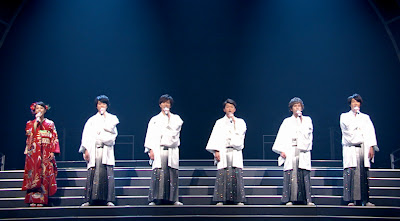
I’ve written about Japanese New Year’s traditions and I’ve even posted some typical Japanese New Year’s dishes. But this year I decided to go whole hog and make an Osechi Jubako from scratch.
You’d think after my recent ramen post (which was nearly a decade in the making), I’d be done with insanely time consuming Japanese food for a while, but I couldn’t resist the urge to share with you the New Year’s food of my people (that, and this project started off as a misguided effort to save some money.)

Osechi Ryori (ã�Šç¯€æ–™ç�†) is a subset of Japanese cuisine made up of dishes that are traditionally eaten on Oshogatsu (New Year’s). Since it was historically taboo to cook on New Year’s day, Osechi dishes are typically stewed with lots of sugar, or they are vinegared to preserve them. There’s a huge variety of dishes, each one, a symbolic wish for things like long life, wealth, fertility, and happiness. The food is then meticulously plated in a 2-3 tiered lacquered box called a jubako, which the whole family eats from. Since I was trying to save some money, I went with a cheap plastic dish that’s intended to be used for serving cold soba.
But enough talk, here’s what was in this year’s osechi:

Gobo Kobumaki (昆布巻) – Burdock root wrapped in kombu, tied with kanpyo (a kind of gourd) and simmered in niboshi dashi. Burdock is a very long root that symbolizes the Japanese ideal of a life, long and stable. This preparation also represents joy, as “kobu” sounds like “yorokobu” which means joyful.
Renkon no Nitsuke (レンコンã�®ç…®ä»˜ã�‘) – Lotus root cut like chrysanthemums then fried and simmered in a sweet soy sauce. The many holes in it allow us to look through to the year ahead.
Kikuka Kabu (è�ŠèŠ±è•ª) – This is a whole baby turnip cut to look like a chrysanthemum flower that’s then pickled in vinegar, salt and sugar with some chili pepper in the middle. The chrysanthemum is the symbol of the emperor and is used to mark joyous occasions.
Pirikara Konnyaku (ピリ辛コンニャク)- Konnyaku (yam jelly) simmered in a sweet and spicy sauce.
Nimono (煮物) – Fresh baby taro, carrots carved like plum blossoms, and shiitake mushrooms simmered in a katsuo/kombu dashi. The shape of the carrots in this dish is symbolic in that every plum flower bears one fruit, making this another wish for fertility.
Kuri Kinton (æ —é‡‘é£©) – Sweetened and mashed Japanese sweet potatoes with sweet chestnuts. The characters for kinton literally mean “group of gold”, so with the golden color of this sweet, it represents a wish for wealth and financial success in the new year.
Ebi no Shioyaki (エビã�®å¡©ç„¼ã��) – I brined these giant shrimp in a 50/50 salt sugar mixture for 5 minutes before grilling on a stove top fish grill. The shape of the shrimp is similar to that of an older person and represents longevity.
Kazunoko (æ•°ã�®å�) – Herring roe seasoned in katsuo/kombu dashi and soy sauce. These crunchy roe sacs each contain thousands of eggs and symbolize a wish for fertility.
Kamaboko (蒲鉾) – The quintessential pink and white Japanese fishcakes are traditionally sliced and layered in alternating rows of pink and white. While it’s a stretch to say that pink and red are the same color, the bands of “red” and white kamaboko are supposed to symbolize the rising sun. I had big plans for doing some elaborate carving here, but after hand carving a dozen carrots in the shape of plum blossoms, I decided to go with a simple slice.
Datemaki (伊é�”å·») – These sweet golden rounds of egg and hanpen (fishcake), have a ribbed outer surface mimicking the shining sun, a wish for sunny days ahead.
Kuromame (黒豆) – Large black soybeans simmered with sugar and soy sauce. Aside from being full of nutrients, this dish also symbolizes good health, as “mame” which means bean, sounds like another word that means hard work and good health. Recipe »
Ikura (イクラ) – Seasoned salmon roe. In addition to being an auspicious shade of red, the eggs represent fertility.

Tazukuri (田作り) – Baby dried anchovies are roasted and coated with sweet caramelized soy sauce and sesame seeds. Tazukuri, which literally translates to “making rice fields” symbolizes a bountiful harvest.
Kohaku Namasu (紅白ã�ªã�¾ã�™) – Red and white vinegared daikon. This dish is traditionally made with carrots and daikon, but I decided to mix it up a bit and used pomegranate seeds instead of carrots, and replaced the sugar that usually goes into it with mandarin juice. The combination of red and white is a recurring theme in many osechi dishes and symbolizes happiness and celebration.

Finally, no oshogatsu meal would be complete without o-zoni (ã�Šé›‘ç…®), a ubiquitous soup with rice cake that has about as many variations as there are cities in Japan. Everything from the stock, to the seasoning to the stuff that’s inside varies, but one common thread is that it always has a piece of mochi (sticky rice cake) inside. For my version, I took some dashi taken from katsuo, kombu, and shiitake and simmered some nankotsu (chicken cartilage) in it for several hours, I seasoned it with soy sauce and mirin, then added ribbons of daikon, and of course, a toasted square of mochi.
 Chef Sakai's Teruhito
Chef Sakai's Teruhito Is provided as a dish (¥ 3,150 ~ noon, night ~ 8400 yen) of Shippoku cuisine "east å�¡ç…®"
Is provided as a dish (¥ 3,150 ~ noon, night ~ 8400 yen) of Shippoku cuisine "east å�¡ç…®" The addition and subtraction under boiled, to make sure to refer him out of of the flesh a bamboo skewer
The addition and subtraction under boiled, to make sure to refer him out of of the flesh a bamboo skewer It's cut in the same weight also manually
It's cut in the same weight also manually Also dropped lid and large pot containing the seasoned, it is not essential to make the taste of Sakamoto-ya
Also dropped lid and large pot containing the seasoned, it is not essential to make the taste of Sakamoto-ya


 Is provided as a dish (¥ 3,150 ~ noon, night ~ 8400 yen) of Shippoku cuisine "east å�¡ç…®"
Is provided as a dish (¥ 3,150 ~ noon, night ~ 8400 yen) of Shippoku cuisine "east å�¡ç…®"




 Chef's MoriManabu
Chef's MoriManabu It's cut to the size of the manual also defines
It's cut to the size of the manual also defines Taste is attached to only the part of the skin before
Taste is attached to only the part of the skin before Go stew together also Rishiri kelp
Go stew together also Rishiri kelp Sauce with a variety of materials permeates the pork, it will become light brown gradually
Sauce with a variety of materials permeates the pork, it will become light brown gradually


 The current store was built in 1927. I did not receive Fortunately war
The current store was built in 1927. I did not receive Fortunately war
























